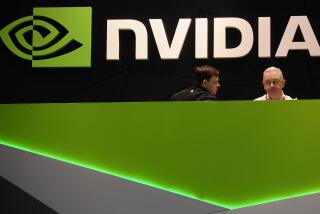Look Out for Those Lean, Mean PCs
When Silicon Graphics Inc. announced last week that financial results for the current quarter would be âsignificantly lowerâ than anticipated, it was the content-free explanation of how the company would attack the problems that fully revealed their severity: âWe clearly need to intensify our marketing and sales programs. . . .â
For the once-highflying vendor of graphics workstations, itâs been quite a come-down. SGI makes the coolest of all computers, the high-powered machines that create âJurassic Parkâ dinosaurs, semiconductor designs and advanced weather simulations. Its chief executive, Ed McCracken, once hobnobbed with President Clinton.
Now sales are stagnant, losses are mounting, and critics are calling for McCrackenâs head.
Management certainly deserves some of the blame. Fundamentally, though, SGI is being damaged by one of the most consistent and powerful forces in the computer world: the tendency of personal computers to get better much faster than more expensive, elaborate computers get cheaper.
Itâs a dynamic that has destroyed numerous companies in the past and stands ready to savage many more. Even red-hot firms like Sun Microsystems may not be immune. And in the long run it could, paradoxically, threaten the PC companies themselves.
To see how all this works, consider the case of the Hollywood special-effects business, a relatively small market but an important one for SGI.
When it first became possible to create special effects on a computer, it was possible only on SGI machines. Though SGI developed its technology for sophisticated scientific and engineering applications, it turned out that its high-speed RISC (reduced instruction set computing) processors, special graphics hardware and Unix-based system software could also be used to generate and manipulate film and video images.
From its inception in the mid-1980s, the digital-effects arena was dominated by a few highly specialized companies--especially George Lucasâ Industrial Light & Magic--that relied on Silicon Graphics computers, which often cost hundreds of thousands of dollars.
As personal computers grew more powerful, though, some of the tasks that one could do on an SGI machine started to become feasible on PCs--initially on Apple Computersâ Macintoshes. Soon, anyone with a high-end Mac in their bedroom--and considerable technical and artistic skills, of course--could get into at least some parts of the digital-effects business.
New, low-cost competitors began to put pressure on the established effects houses, which had to charge movie producers enough to pay for all the expensive SGI workstations.
In the meantime, PCs based on Intelâs Pentium microprocessors were improving so fast that they were beginning to approach the RISC-based workstations from SGI, Sun Microsystems, Hewlett-Packard and Digital Equipment in processing power. And Microsoft was substantially improving its Windows NT operating system--designed as a competitor to Unix.
When the effects business went through a down cycle this summer, companies such as Marina del Rey-based Boss Films, which had millions of dollars tied up in SGI computers and software, couldnât keep their doors open. In-house effects operations at several major studios were also scaled back. Everyone in the business was forced to look hard at costs.
SGI, of course, wasnât standing still through all this. Its most recent line of low-end systems start at about $6,000, not much more than a well-equipped PC. But in order to compete with PCs, itâs being forced to cannibalize its own business--selling essentially the same capabilities for half the price.
âIn two years, weâll probably be 50-50â between SGI workstations and NT machines, says Thad Beier, a partner at Hammerhead Productions, a Studio City-based effects firm that uses SGI equipment exclusively right now.
McCracken acknowledges that SGI âtook a little too long to realize the fundamental changes in the market being brought on by Intel and Microsoft.â The solution? To build machines with Intel chips and NT software, and hope that SGI graphics hardware and software and overall quality will be enough to distinguish them from the âWintelâ pack.
This will likely be difficult, though. The PC business is a mass-market, commodity business, with very high volume and very low profit margins. High-end systems companies like SGI are by their nature ill-equipped to compete on price with lean-and-mean PC companies like Dell and Compaq.
There are a lot of companies that know this dilemma well. IBM was brought to its knees when PCs and workstations began offering far cheaper alternatives to its mainframes; it took IBM years to develop a cost structure that made it a viable competitor in the PC business.
The same thing happened to Digital Equipment and even more dramatically to minicomputer companies like Data General. They simply couldnât compete in markets that were turned upside-down by commodity PCs. Neither could Apple Computer.
Others will be facing this music soon. Sun, which has prospered selling both stand-alone technical workstations and âserversâ--big machines that serve as a hub for many other machines and often perform functions once reserved for mainframes--clearly faces a big challenge from NT-based servers.
Indeed, Sunâs big push on the Java software technology for the Internet stems partly from the realization that its core computer business is vulnerable to this kind of attack.
The PC companies themselves are subject to the same dynamic. As the Intel chip technology continues to advance, the PC market will become more segmented. Historically, the whole market has moved relatively quickly to new generations of technology, but thatâs not happening the same way now: The Pentium will likely survive for many years even though thereâs now a Pentium II.
Further, new ânetwork computingâ devices and hand-held PCs increasingly have very different designs--and radically lower prices--than traditional PCs. Thus, even a Compaq or a Dell, as they increasingly focus more on big, sophisticated customers, will probably face rivals coming up from below with even cheaper, more commodity-like machines.
SGI, for its part, is counting on a big move into the server business to restore its momentum. (The company believes its servers are especially effective for archiving and managing images and video.) With the acquisition of Cray Research last year, it has a dominant position in very-high-performance computing. With better execution, it should be able to smooth out its short-term problems.
But if thereâs one thing the recent history of the computer business shows, itâs that the high end is a dangerous place to be.
*
Jonathan Weber ([email protected]) is editor of The Cutting Edge.






